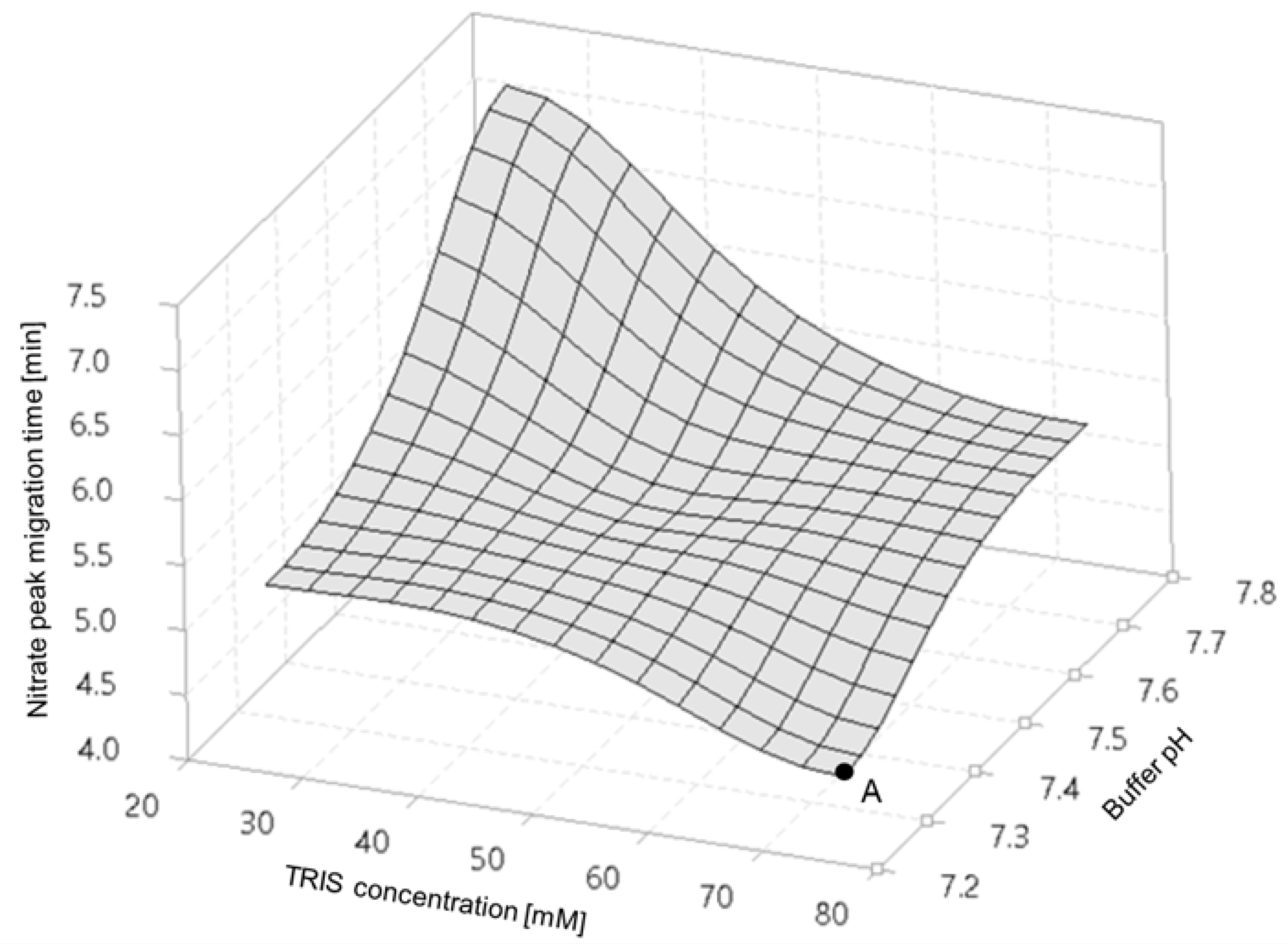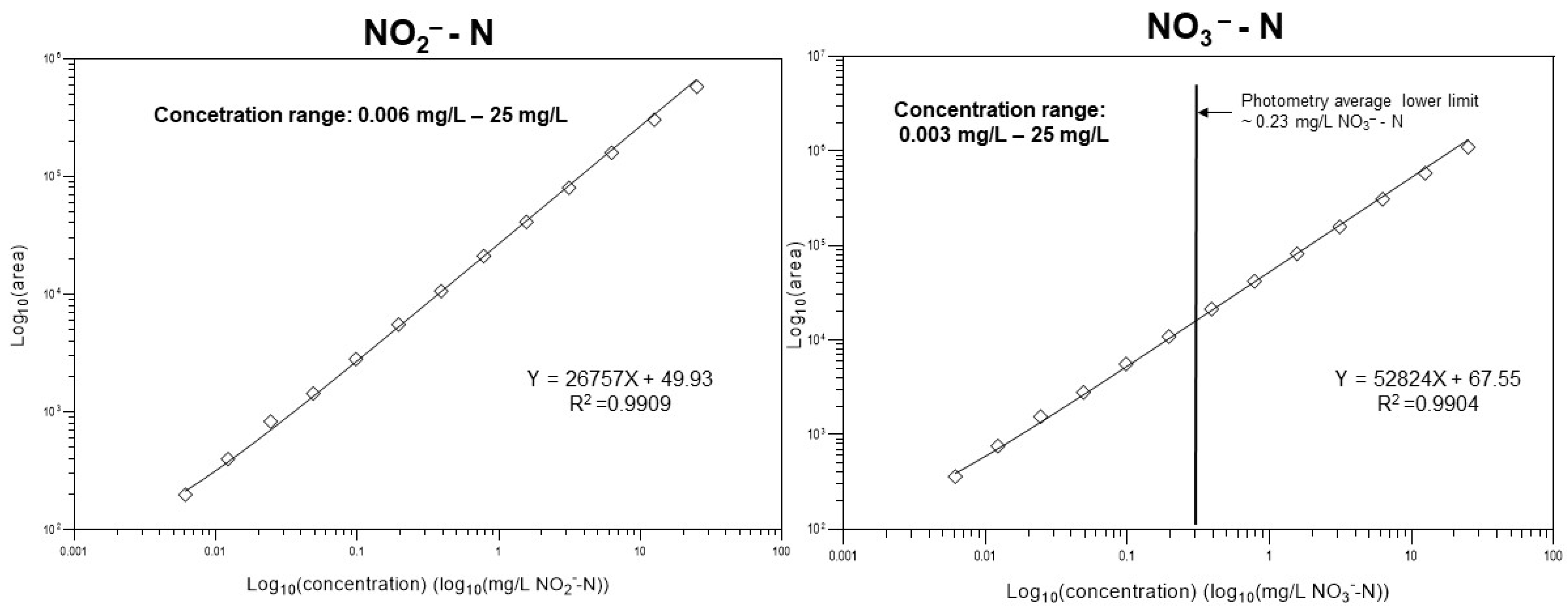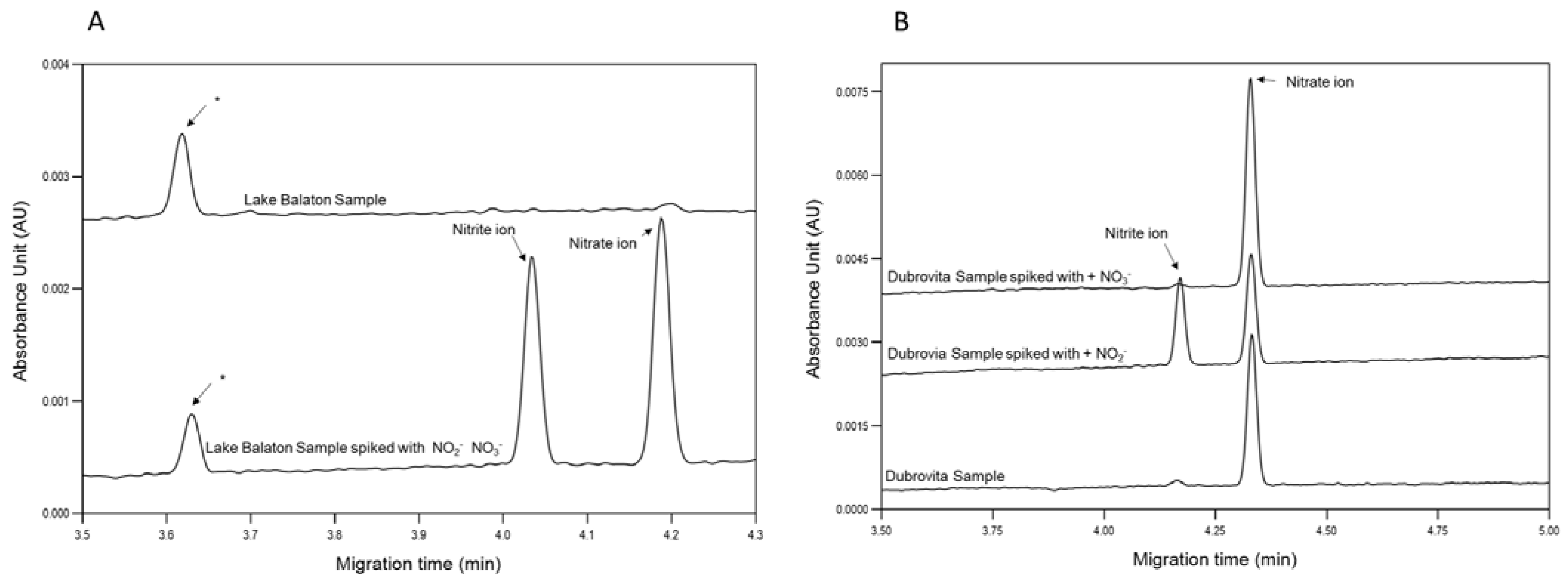Ultrahigh-Sensitivity Capillary Electrophoresis Analysis of Trace Amounts of Nitrate and Nitrite in Environmental Water Samples
Abstract
1. Introduction
2. Materials and Methods
2.1. Chemicals
2.2. Capillary Electrophoresis
2.3. Sample Handling and Calibration Series
3. Results
3.1. Separation Optimization
3.2. Calibration
3.3. Determination of Nitrate and Nitrite in Surface Water Samples
4. Conclusions
Supplementary Materials
Author Contributions
Funding
Data Availability Statement
Acknowledgments
Conflicts of Interest
References
- Vitousek, P.M.; Aber, J.D.; Howarth, R.W.; Likens, G.E.; Matson, D.W.S.; Schlesinger, W.H.; Tilman, D.G. Human alteration of the global nitrogen cycle: Sources and consequences. Ecol. Appl. 1997, 7, 737–750. [Google Scholar] [CrossRef]
- Camargo, J.A.; Alonso, A.; Salamanca, A. Nitrate toxicity to aquatic animals: A review with new data for freshwater invertebrates. Chemosphere 2005, 58, 1255–1267. [Google Scholar] [CrossRef] [PubMed]
- Moorcroft, M.J.; Davis, J.; Compton, R.G. Detection and determination of nitrate and nitrite: A review. Talanta 2001, 54, 785–803. [Google Scholar] [CrossRef]
- Sah, R.N. Nitrate-nitrogen determination—A critical review. Commun. Soil Sci. Plant Anal. 1994, 25, 2841–2869. [Google Scholar] [CrossRef]
- American Public Health Association (APHA), A.W.W.A. and a.W.E.F.W. (AWWA). Standard Methods for the Examination of Water and Wastewater, 18th ed.; American Public Health Association: Washington DC, USA, 1992. [Google Scholar]
- Goldman, E.; Jacobs, R. Determination of Nitrates by Ultraviolet Absorption. J. Am. Water Work. Assoc. 1961, 53, 187–191. [Google Scholar] [CrossRef]
- Norman, R.J.; Edberg, J.C.; Stucki, J.W. Determination of Nitrate in Soil Extracts by Dual-wavelength Ultraviolet Spectrophotometry. Soil Sci. Soc. Am. J. 1985, 49, 1182–1185. [Google Scholar] [CrossRef]
- Norman, R.J.; Stucki, J.W. The Determination of Nitrate and Nitrite in Soil Extracts by Ultraviolet Spectrophotometry. Soil Sci. Soc. Am. J. 1981, 45, 347–353. [Google Scholar] [CrossRef]
- Mubarak, A.T.; Mohamed, A.A.; Fawy, K.F.; Al-Shihry, A.S. A novel kinetic determination of nitrite based on the perphenazine-bromate redox reaction. Mikrochim. Acta 2006, 157, 99–105. [Google Scholar] [CrossRef]
- Tomiyasu, T.; Konagayoshi, Y.; Anazawa, K.; Sakamoto, H. A Kinetic Method for the Determination of Nitrite by Its Catalytic Effect on the Oxidation of Chlorpromazine with Nitric Acid. Anal. Sci. 2001, 17, 1437–1440. [Google Scholar] [CrossRef][Green Version]
- Guttman, A.; Hajba, L. Chapter five-Applications. In Capillary Gel Electrophoresis; Guttman, A., Hajba, L., Eds.; Elsevier: Boston, MA, USA, 2022; pp. 199–349. [Google Scholar]
- Guttman, A. High-resolution carbohydrate profiling by capillary gel electrophoresis. Nature 1996, 380, 461–462. [Google Scholar] [CrossRef]
- Schuur, B.; Haan, A.B.; Kaspereit, M.; Leeman, M. 2.52-Chiral Separations. In Comprehensive Biotechnology, 2nd ed.; Moo-Young, M., Ed.; Academic Press: Burlington, NJ, USA, 2011; pp. 737–751. [Google Scholar]
- Le, T.H.H.; Nguyen, T.Q.H.; Tran, S.C.; Vu, T.T.; Nguyen, T.L.; Cao, V.H.; Ta, T.T.; Pham, T.N.M.P.; Nguyen, T.A.H.N.; Mai, T.D. Screening determination of food additives using capillary electrophoresis coupled with contactless conductivity detection: A case study in Vietnam. Food Control 2017, 77, 281–289. [Google Scholar] [CrossRef]
- Boyce, M.C. Determination of additives in food by capillary electrophoresis. Electrophoresis 2001, 22, 1447–1459. [Google Scholar] [CrossRef]
- Kaniansky, D.; Marak, J.; Masar, M.; Bodor, R. Capillary electrophoresis of inorganic anions1 Dedicated to the memory of Professor Samo Stankoviansky on the occasion of his 90th birthday.1. J. Chromatogr. A 1999, 834, 133–178. [Google Scholar] [CrossRef]
- Marshall, P.A.; Trenerry, V. The determination of nitrite and nitrate in foods by capillary ion electrophoresis. Food Chem. 1996, 57, 339–345. [Google Scholar] [CrossRef]
- Martínková, E.; Křížek, T.; Coufal, P. Determination of nitrites and nitrates in drinking water using capillary electrophoresis. Chem. Pap. 2014, 68, 1008–1014. [Google Scholar] [CrossRef]
- Guan, F.; Wu, H.; Luo, Y. Sensitive and selective method for direct determination of nitrite and nitrate by high-performance capillary electrophoresis. J. Chromatogr. A 1996, 719, 427–433. [Google Scholar] [CrossRef]
- Jimidar, M.; Hartmann, C.; Cousement, N.; Massart, D. Determination of nitrate and nitrite in vegetables by capillary electrophoresis with indirect detection. J. Chromatogr. A 1995, 706, 479–492. [Google Scholar] [CrossRef]
- Morcos, E.; Wiklund, N.P. Nitrite and nitrate measurement in human urine by capillary electrophoresis. Electrophoresis 2001, 22, 2763–2768. [Google Scholar] [CrossRef]
- Melanson, J.E.; A Lucy, C. Ultra-rapid analysis of nitrate and nitrite by capillary electrophoresis. J. Chromatogr. A 2000, 884, 311–316. [Google Scholar] [CrossRef]
- Leone, A.M.; Francis, P.L.; Rhodes, P.; Moncada, S. A Rapid and Simple Method for the Measurement of Nitrite and Nitrate in Plasma by High Performance Capillary Electrophoresis. Biochem. Biophys. Res. Commun. 1994, 200, 951–957. [Google Scholar] [CrossRef]
- Chun, M.-S.; Kang, D.; Kim, Y.; Chung, D. Protein analysis with large volume sample stacking with an electroosmotic flow pump: A potential approach for proteomics. Microchem. J. 2001, 70, 247–253. [Google Scholar] [CrossRef]



Publisher’s Note: MDPI stays neutral with regard to jurisdictional claims in published maps and institutional affiliations. |
© 2022 by the authors. Licensee MDPI, Basel, Switzerland. This article is an open access article distributed under the terms and conditions of the Creative Commons Attribution (CC BY) license (https://creativecommons.org/licenses/by/4.0/).
Share and Cite
Farsang, R.; Kovacs, Z.; Jarvas, G.; Guttman, A. Ultrahigh-Sensitivity Capillary Electrophoresis Analysis of Trace Amounts of Nitrate and Nitrite in Environmental Water Samples. Separations 2022, 9, 333. https://doi.org/10.3390/separations9110333
Farsang R, Kovacs Z, Jarvas G, Guttman A. Ultrahigh-Sensitivity Capillary Electrophoresis Analysis of Trace Amounts of Nitrate and Nitrite in Environmental Water Samples. Separations. 2022; 9(11):333. https://doi.org/10.3390/separations9110333
Chicago/Turabian StyleFarsang, Robert, Zsofia Kovacs, Gabor Jarvas, and Andras Guttman. 2022. "Ultrahigh-Sensitivity Capillary Electrophoresis Analysis of Trace Amounts of Nitrate and Nitrite in Environmental Water Samples" Separations 9, no. 11: 333. https://doi.org/10.3390/separations9110333
APA StyleFarsang, R., Kovacs, Z., Jarvas, G., & Guttman, A. (2022). Ultrahigh-Sensitivity Capillary Electrophoresis Analysis of Trace Amounts of Nitrate and Nitrite in Environmental Water Samples. Separations, 9(11), 333. https://doi.org/10.3390/separations9110333






